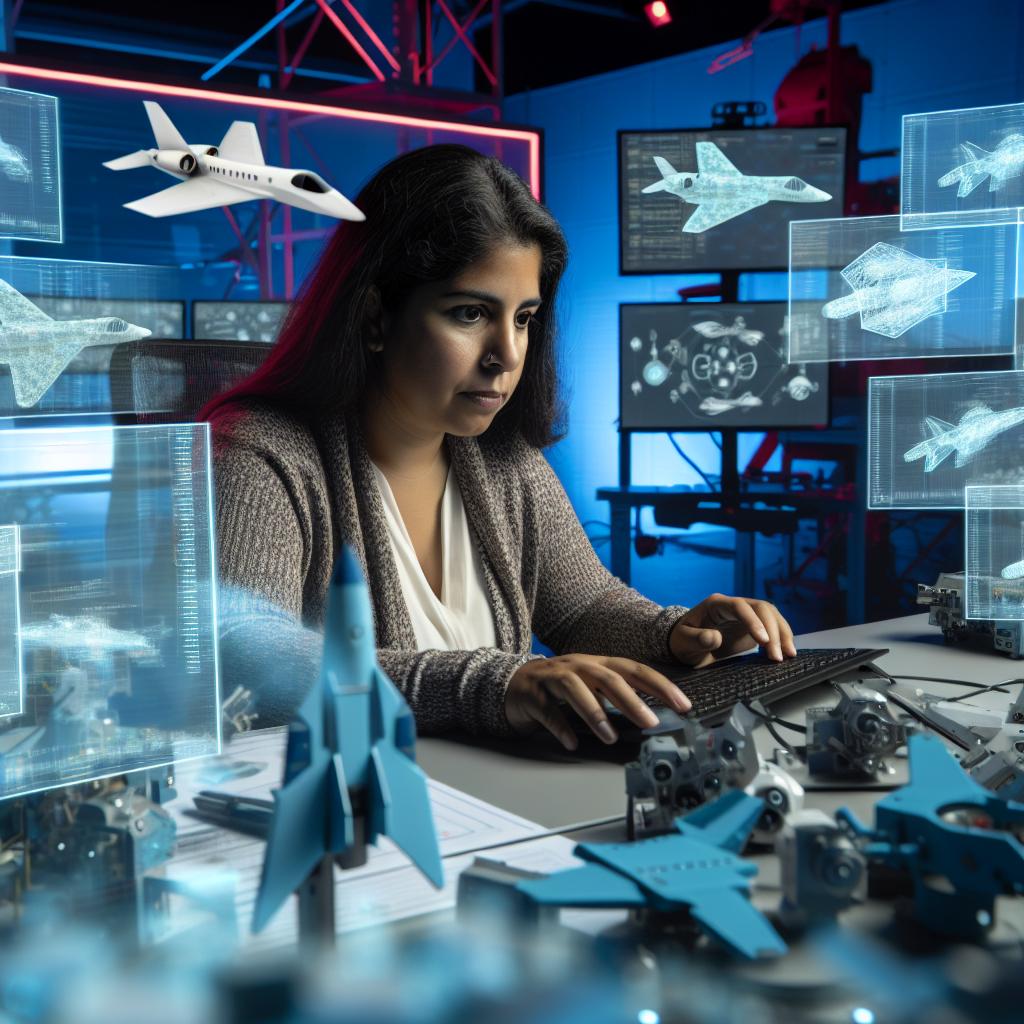Introduction to Aerospace Engineering and its Role in Modern Technology
Aerospace engineering is a vital field impacting modern technology significantly.
This discipline combines elements of mechanical and electrical engineering.
Aerospace engineers design and develop aircraft, spacecraft, satellites, and missiles.
Moreover, they contribute to improving transportation efficiency and safety.
They work alongside various industries, enhancing technological advancements.
The Significance of Aerospace Engineering
Aerospace engineering drives innovation across multiple sectors.
It plays a crucial role in telecommunications through satellite technology.
Furthermore, aerospace advancements influence commercial aviation standards.
This engineering branch also addresses environmental concerns by optimizing fuel consumption.
Consequently, it promotes sustainable practices in aviation and space exploration.
Collaboration Across Industries
Aerospace engineers often collaborate with automotive and energy sectors.
These partnerships lead to breakthroughs in materials and design methodologies.
For example, lightweight materials enhance both aircraft and electric vehicles.
Additionally, simulations and modeling techniques improve the development of new technologies.
As a result, industries can innovate more efficiently while reducing costs.
Education and Training
Aerospace engineers typically hold degrees in aerospace or mechanical engineering.
They engage in rigorous training programs to acquire necessary skills.
Furthermore, ongoing education remains essential in this rapidly evolving field.
Engineers must stay updated on technological advancements and regulations.
This commitment ensures they can design safe and cutting-edge aerospace systems.
Future Trends in Aerospace Engineering
Looking ahead, aerospace engineering faces exciting challenges and opportunities.
Electric and hybrid propulsion systems are gaining traction in aviation.
Additionally, the push for space exploration drives advancements in rocket technology.
Engineers now focus on developing reusable launch systems to reduce costs.
Moreover, autonomous and unmanned aerial vehicles are expanding market roles.
Unlock Your Career Potential
Visualize a clear path to success with our tailored Career Consulting service. Personalized insights in just 1-3 days.
Get StartedThese trends show how aerospace engineering continues to shape modern technology.
The Historical Evolution of Aerospace Engineering and Its Impact on Technology
Early Developments in Aviation
Aerospace engineering began in the early 20th century.
Pioneers like the Wright brothers made significant advancements.
They invented controlled flight, revolutionizing travel.
Other inventors, such as Alberto Santos-Dumont, contributed important designs.
These early innovations set the stage for modern aircraft.
World War Advancements
World War I and II spurred rapid technological advancement.
Governments invested heavily in research and development.
Military needs led to innovations in aerodynamics and materials.
A notable example includes the development of jet engines.
This technology greatly improved aircraft performance and speed.
The Space Race Era
The Cold War ignited the Space Race between superpowers.
Aerospace engineers designed spacecraft and satellites for exploration.
NASA’s Apollo program showcased human capabilities in space travel.
Ultimately, the inventions from this era benefitted civilian technology.
For instance, satellite communications became mainstream afterward.
Current Innovations in Aerospace Engineering
Today’s aerospace engineering continues to evolve rapidly.
Technological advancements now focus on sustainability.
Engineers are developing more efficient fuel systems.
Electric and hybrid aircraft are being designed for the future.
Additionally, advancements in automation are enhancing safety and efficiency.
Impact on Daily Technology
Aerospace engineering influences various modern technologies.
GPS, originally designed for military use, benefits daily life.
Telecommunications have also improved due to satellite technology.
Moreover, materials developed for aerospace often find use in consumer products.
This includes lightweight and durable materials in automotive sectors.
Key Innovations in Aerospace Engineering That Have Transformed Other Industries
Advancements in Materials
Aerospace engineers utilize innovative materials to enhance aircraft performance.
Composites like carbon fiber significantly reduce weight and increase fuel efficiency.
These materials also find applications in automotive and sports equipment.
Additionally, lightweight materials improve energy efficiency in other sectors.
Propulsion Technologies
Modern aerospace propulsion systems have revolutionized energy use.
High-efficiency jet engines minimize fuel consumption and emissions.
These advancements in influence automotive designs, leading to greener vehicles.
Moreover, electrification trends in aviation inspire shifts in public transportation systems.
Avionics and Automation
Aerospace engineers develop advanced avionics for enhanced navigation and safety.
Autonomous systems from aviation are now being integrated into various industries.
Notably, drone technology plays a role in agriculture and infrastructure inspection.
Furthermore, these systems optimize logistics in shipping and delivery services.
Simulation and Modeling
The aerospace sector heavily relies on simulation tools for design and testing.
These tools help engineers create reliable models before physical prototypes.
Subsequently, industries like architecture and civil engineering adopt similar practices.
This approach reduces costs and accelerates project timelines in those fields.
Sustainability Initiatives
Aerospace engineering pushes for sustainability in technology advancements.
Researchers focus on developing alternative fuels to reduce environmental impact.
Such initiatives influence renewable energy strategies across various industries.
In fact, biofuels and hydrogen technologies are now expanding into automotive sectors.
Impact on Telecommunications
Aerospace technology has significantly improved global telecommunications.
Satellite technology enables high-speed internet access worldwide.
This innovation facilitates connectivity in remote areas underserved by traditional infrastructure.
Consequently, reliable communication systems enhance productivity across diverse sectors.
Human Factors Engineering
Aerospace engineers prioritize human factors for improved user experience.
Designing cockpit interfaces enhances pilot efficiency and safety.
This focus spills over into other areas, like consumer electronics and automotive design.
Subsequently, industries place greater emphasis on user-centered design methodologies.
Gain More Insights: Chemical Engineering Internships and Career Growth
The Role of Aerospace Engineers in Advancements in Drone and UAV Technology
Designing Innovative Drones
Aerospace engineers design cutting-edge drones and UAVs.
Their expertise combines aerodynamics and materials science.
Engineers work to improve flight efficiency continuously.
They also focus on maximizing payload capacity.
Advanced computational tools aid in design simulations.
Enhancing Flight Control Systems
Aerospace engineers develop advanced flight control systems.
These systems ensure stability and reliability in flight.
Engineers utilize algorithms for real-time data processing.
This approach enhances navigational accuracy significantly.
Additionally, they integrate automation features for safety.
Pioneering New Technologies
Aerospace engineers lead the way in drone-related technology.
They explore autonomous flight capabilities extensively.
Engineers also investigate battery efficiency improvements.
This research focuses on longer flight durations.
Moreover, they are involved in communication technology innovations.
Applications in Various Industries
Drones are transforming industries through aerospace engineering.
Healthcare utilizes drones for medical supply deliveries.
Agriculture benefits from UAVs for monitoring crops.
Furthermore, inspections in construction and infrastructure are revolutionized.
These applications demonstrate engineers’ broad impact on society.
Discover More: How Metallurgical Engineers Impact Everyday Life
How Aerospace Engineering Contributes to Sustainable Aviation and Environmental Technology
Advancements in Aircraft Design
Aerospace engineers significantly improve aircraft efficiency.
They design lighter materials that reduce fuel consumption.
Furthermore, innovative aerodynamic shapes minimize drag.
These enhancements directly contribute to lower CO2 emissions.
Recent models feature advanced wing designs for better lift.
Development of Alternative Fuels
Aerospace engineers actively study alternative fuels.
These fuels include biofuels and synthetic options.
The goal is to decrease reliance on fossil fuels.
Research shows that alternative fuels can cut greenhouse gas emissions.
Airlines are now exploring sustainable aviation fuel (SAF) options.
Noise Reduction Technologies
Reducing aircraft noise is a priority for aerospace engineers.
They implement technologies to minimize noise pollution around airports.
New engine designs contribute to quieter takeoffs and landings.
Additionally, sound-absorbing materials are used in aircraft interiors.
This focus enhances the quality of life for nearby communities.
Regulatory Compliance and Safety Protocols
Aerospace engineers ensure compliance with environmental regulations.
They develop safety protocols that protect the ecosystem.
This work includes monitoring emissions during flight operations.
Engineers collaborate with regulatory bodies for industry standards.
Their efforts foster safe and sustainable aviation practices.
Innovative Technologies for Monitoring and Assessment
Aerospace engineers utilize technology for environmental monitoring.
They design systems to assess emissions from aircraft.
These systems help identify areas for improvement.
Moreover, data analysis leads to targeted strategies for emission reduction.
Such advancements underpin ongoing environmental assessments.
Future Directions in Sustainable Aviation
The aerospace sector is focused on continued innovation.
Researchers are exploring electric and hybrid aircraft technologies.
These alternatives promise significant emissions reductions.
Aerospace engineers play a key role in this transition.
They are shaping the future of sustainable aviation practices.
Gain More Insights: Exploring Automation as a Mechatronics Engineer in Canada

The Integration of Aerospace Engineering Principles in Space Exploration Technologies
Advancements in Rocket Propulsion
Aerospace engineers drive advancements in rocket propulsion systems.
They develop efficient engines for launching spacecraft.
In addition, engineers innovate with reusable rocket technology.
This technology reduces costs and increases sustainability in space travel.
Companies like SpaceX exemplify this shift toward reusability.
Satellite Technology and Communication
Aerospace engineers design advanced satellites for communication.
These satellites enhance global connectivity and signal transmission.
Additionally, they contribute to Earth observation and data collection.
This data aids in climate monitoring and disaster response.
Notably, companies such as Boeing and Lockheed Martin lead in this sector.
Space Habitats and Human Factors Engineering
Engineers focus on creating life-support systems for space habitats.
Human factors engineering ensures crew comfort and efficiency.
Systems include air circulation, temperature control, and waste management.
NASA’s research on the International Space Station highlights these efforts.
The Role of Simulation and Testing
Simulation technologies play a crucial role in aerospace engineering.
Engineers use simulators for testing spacecraft in various scenarios.
This approach identifies potential issues before real-life launches.
Furthermore, it ensures the safety and reliability of technologies.
Organizations like Blue Origin utilize rigorous testing protocols.
Future Trends in Aerospace Engineering
The future of aerospace engineering appears promising and innovative.
Engineers are exploring space tourism and interplanetary travel.
Moreover, advancements in artificial intelligence will enhance mission success.
Companies such as Virgin Galactic are pushing boundaries in this area.
Ultimately, aerospace engineers will continue to shape modern technology.
See Related Content: Benefits of a Career in Metallurgical Engineering
Collaboration Between Aerospace Engineers and Other Fields
Interdisciplinary Partnerships
Aerospace engineers often collaborate with professionals from various fields.
This collaboration enhances technological advancements in many industries.
For instance, aerospace engineers work closely with software developers.
They create sophisticated simulations that test aircraft performance.
Such simulations also apply to automotive and energy sectors.
Additionally, partnerships with materials scientists improve product durability.
They develop lighter and stronger materials for aircraft structures.
Case Study: The Boeing and NASA Partnership
The collaboration between Boeing and NASA showcases effective teamwork.
This partnership focuses on developing sustainable aviation technologies.
Aerospace engineers utilize advanced computing techniques to minimize emissions.
They work on projects that aim to achieve carbon neutrality.
These efforts improve air travel’s environmental impact significantly.
Military Applications and Technology Transfer
Aerospace engineers contribute to military applications through innovation.
They design advanced drones for reconnaissance missions.
The technology from these military applications often adapts for civilian use.
For example, GPS technology originated from military aerospace research.
Healthcare Technology Innovations
Aerospace engineering also influences the healthcare sector.
Engineers apply aerospace methods to develop advanced medical devices.
Examples include 3D-printed surgical instruments and imaging devices.
The precision of aerospace techniques improves surgical outcomes.
Future Impact Through Robotics
The future of aerospace engineering lies significantly in robotics.
Engineers now design autonomous systems for various applications.
These systems enhance efficiency in manufacturing and logistics.
Collaboration with robotics engineers can revolutionize space exploration.
The use of autonomous drones for planetary missions is a notable example.
Future Directions for Aerospace Engineering and Potential Technologies That Could Emerge
Advancements in Materials
Aerospace engineers continuously explore new materials for aircraft and spacecraft.
Innovative composites can reduce weight while increasing strength.
Additionally, materials with self-healing properties may enhance safety and longevity.
Integration of Artificial Intelligence
Artificial intelligence is becoming crucial in aerospace design and operations.
Engineers use AI to optimize flight paths and fuel consumption.
Moreover, autonomous systems can enhance safety during critical flight phases.
Green Technologies
Aerospace engineering increasingly focuses on sustainability and reducing emissions.
Hybrid electric propulsion systems are a promising area of research.
Engineers are developing biofuels derived from renewable sources.
These initiatives significantly lower the carbon footprint of air travel.
Space Exploration Innovations
The future of aerospace lies in expanding humanity’s presence in space.
Engineers are designing reusable launch systems to lower space travel costs.
Additionally, in-orbit manufacturing techniques suggest enhanced mission capabilities.
These technologies will support long-term human habitation on other worlds.
Enhanced Safety Protocols
Safety remains a priority in aerospace engineering advancements.
Engineers are creating more sophisticated testing methods for aircraft systems.
Furthermore, simulation technologies provide realistic training for pilots and crew.
This emphasis on safety will bolster public confidence in air travel.
Future of Unmanned Aerial Vehicles
The development of unmanned aerial vehicles (UAVs) continues to advance rapidly.
Engineers are designing UAVs for various applications, including delivery and surveillance.
Collaboration across industries is enhancing UAV functionality and efficiency.
Collaboration Across Disciplines
Future aerospace engineering initiatives will require interdisciplinary collaboration.
Engineers will work closely with computer scientists, materials scientists, and environmentalists.
This collaboration will drive innovative solutions to complex challenges.
Additional Resources
NSF 25-508: Designing Materials to Revolutionize and Engineer our …




